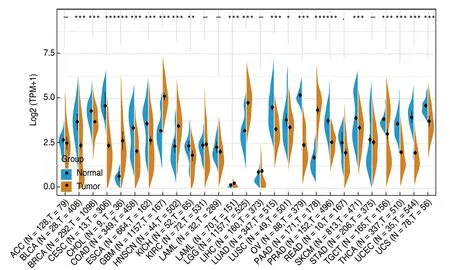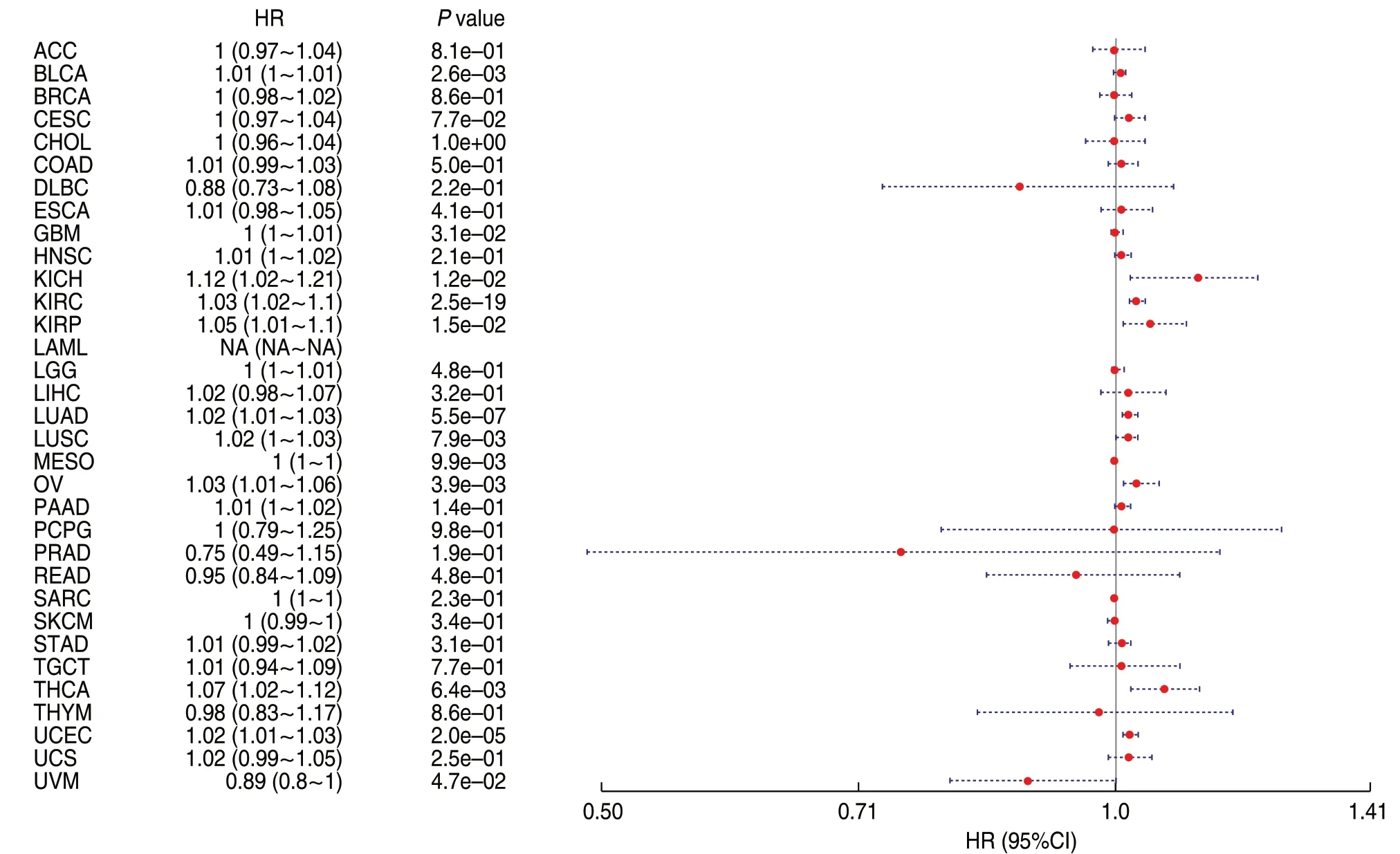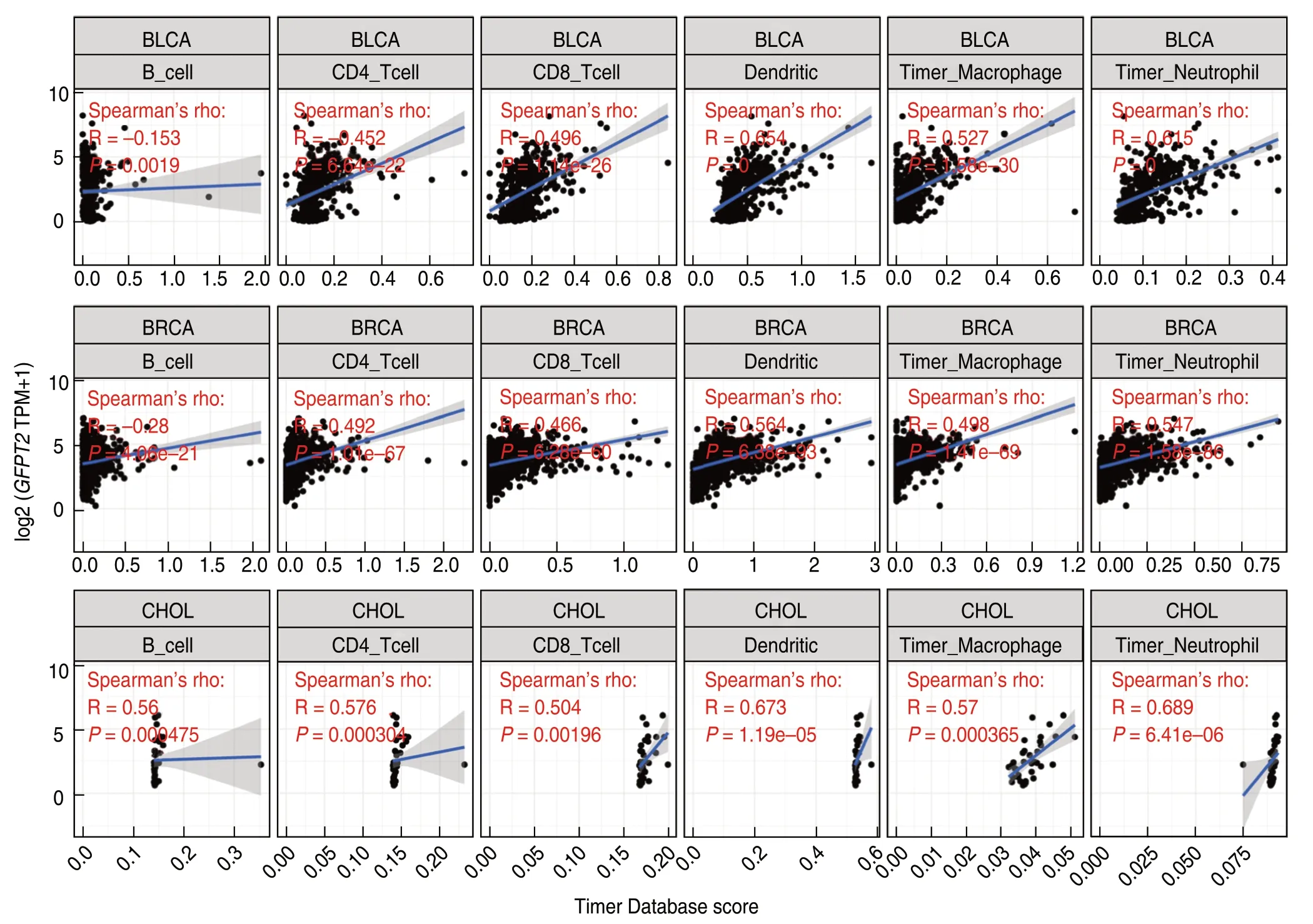GFPT2 pan-cancer analysis and its prognostic and tumor microenvironment associations*
Jiachen Zhang,Ting Wang,Siang Wei,Shujia Chen,Juan Bi (✉)
1 Department of Pharmacy,The First Affiliated Hospital,Naval Medical University,Shanghai 200002,China 2 Jinzhou Medical University,Liaoning 121000,China
3 Department of Pharmacy,The First Affiliated Hospital of Anhui Medical University,Anhui 230022,China
Abstract Objective Glutamine fructose-6-phosphate transaminase 2 (GFPT2) is involved in a wide range of biological functions in human cancer.However,few studies have comprehensively analyzed the correlation between GFPT2 and different cancer prognoses and tumor microenvironments (TMEs).Methods We evaluated the expression level and prognostic value of GFPT2 using updated public databases and multiple comprehensive bioinformatics analysis methods and explored the relationship between GFPT2 expression and immune infiltration,immune neoantigens,tumor mutational burden (TMB),and microsatellite instability in pan-cancer.Results GFPT2 was highly expressed in five cancers.GFPT2 expression correlates with the prognosis of several cancers from The Cancer Genome Atlas (TCGA) and is significantly associated with stromal and immune scores in pan-cancer.High GFPT2 expression in BLCA,BRCA,and CHOL was positively correlated with the infiltration of immune cells,such as B-cells,CD4+T,CD8+T cells,dendritic cells,neutrophils,and macrophages.Conclusion High GFPT2 expression may modify the outcomes of patients with BLCA,BRCA,or CHOL cancers by increasing immune cell infiltration.These findings may provide insights for further investigation into GFPT2 as a potential target in pan-cancer.
Key words:Glutamine fructose-6-phosphate transaminase 2 (GFPT2);pan-cancer,prognosis,immune,microenvironment
According to the global cancer statistics in 2018,it was estimated that there would be 18.1 million new cancer cases and 9.6 million cancer deaths in 2018[1].The World Health Organization estimated that the number of cancer cases worldwide is likely to increase by 60% over the next 20 years[2].Cancer incidence and mortality is rapidly increasing worldwide.The reasons are complex,but they reflect population aging and growth and changes in the prevalence and distribution of the major cancer risk factors associated with socioeconomic development[3].Cancer is associated with various genes,and the accumulation of molecular modifications in the somatic genome is fundamental to cancer progression.Traditional therapies,including surgery,radiotherapy,and chemotherapy,remain the first treatments for most cancer patients.However,breakthroughs in targeted therapy and immune checkpoint blockade therapy have significantly improved cancer patient survival[4-6].
Thus far,many studies have investigated how microenvironments and immune cell infiltration contribute to cancer development.Cancer tissue contains not only cancer cells but also non-cancer cells,such as stromal and immune cells[7].Non-cancer cells dilute cancer cell purity and play an important role in cancer biology[8].Under different purity conditions,the generally accepted prediction index is no longer valid.Therefore,the composition and proportion of stromal cells and immune cells in a tumor may determine the clinical prognosis of patients.In colon cancer,low tumor purity is associated with poor prognosis because of the high mutation frequency of key pathways and purityrelated microenvironment changes[9].In these biological processes,immune-related genes may affect cancer patient prognosis by affecting the abundance of infiltrating immune cells.Therefore,it is necessary to identify the immune-related genes of a specific tumor phenotype to clarify its exact mechanism and find biomarkers or targets for tumor diagnosis and treatment.
As a key factor in the hexosamine biosynthesis signaling pathway,glutamine fructose-6-phosphate transaminase 2 (GFPT2) protein phosphorylation promotes glycosylation of downstream protein O-GlcNAc and mediates various physiological and pathological cell activities.Recent studies have confirmed that GFPT family proteins play an important role in the occurrence and development of various cancers.However,the relationship betweenGFPT2and cancer immune cells is still unclear,limiting our understanding of the specific function ofGFPT2in the occurrence and development of cancer and the implementation of therapeutic measures.
In the current study,we comprehensively analyzed the prognostic value ofGFPT2in pan-cancer via multiple databases,including the GTEx,Cancer Genome Atlas (TCGA),TIMER,and PrognoScan.We also evaluated the potential association betweenGFPT2expression and the tumor microenvironment (TME).Furthermore,we examined the relationship betweenGFPT2expression and immune score and matrix score in pan-cancer.We comprehensively evaluated the expression level and prognostic value ofGFPT2based on multiple public resources and integrated bioinformatics analysis.
Materials and methods
Analyzing GFPT2 expression in various cancers
Considering there are a relatively small number of normal samples in TCGA database,we analyzed the expression differences of 27 kinds of tumors based on the data of normal tissues in the GTEx database and TCGA tumor tissues.In the figure,*indicatesP< 0.05,** indicatesP< 0.01,and***indicatesP< 0.001.
Prognostic analysis of GFPT2 expression in cancer patients
We used gene expression profile data to analyze gene expression and prognosis in tumors.Considering that there may be non-tumor death factors during followup,the researchers analyzed the relationship between gene expression and prognosis of disease-specific survival (DSS) in 33 tumors of TCGA database and made a forest map and Kaplan-Meier (KM) curve of tumor prognosis.
Gene expression and immune relationship in various tumor cells
Tumor-infiltrating lymphocytes are an independent predictor of the status and presence of cancer in sentinel lymph nodes.We studied whether gene expression is related to the level of immune cell infiltration in different types of cancer.Firstly,we downloaded the score data of six kinds of immune infiltrating cells in 33 types of cancer from the TIMER database,and the correlations between gene expression and immune cell score were analyzed,respectively.Three tumors in which GFPT2 is most closely related to immune cells are demonstrated.Then,the immune scores and matrix scores of various tumor samples were analyzed by using the R software package estimate.The relationship between gene expression and immune score,gene expression,and matrix score the most significant first three tumors were observed in 33 tumors.Finally,we collected more than 40 common immune checkpoint genes,analyzed the relationship between gene expression and immune checkpoints,extracted these immune checkpoint genes,respectively,and calculated the correlation with the target gene’s expression.*representsP< 0.05,**representsP< 0.01,and***representsP< 0.001.
Results
Gene expression in pan-cancer
Combined with the data analysis of normal tissue in the GTEx database and TCGA tumor tissue,GFPT2was differentially expressed in 27 types of cancer.Among them,GFPT2was highly expressed in CHOL,GBM,HNSC,LAML,LGG,and PAAD but was significantly lower in BLCA,BRCA,CESC,COAD,ESCA,KICH,LUAD,LUSC,OV,PRAD,SKCM,TGCT,THCA,UCEC,and UCS (Fig.1).Therefore,GFPT2can be used as a biomarker to detect these 21 kinds of cancer.

Fig.1 GFPT2 expression in normal and cancer tissues
Prognosis analysis of genes in pan-cancer
Prognosis analysis (Fig.2) showed that there was a significant correlation between gene expression and cancer hazard ratios (HRs),including KICH [1.12 (1.02-1.21),P=1.2e-02],KIRC [1.03 (10.2-1.04),P=2.5e-19],OV [1.03 (1.01-1.06),P=1.4e-01],and THCA [1.07 (1.02-1.12),P=6.4e-03].The HR value ofGFPT2in pancancer and the prognosis analysis showed that the ratio ofGFPT2to the risk function of renal cancer was higher,which may be related to the larger energy demands of the kidneys,andGFPT2played an important role in the regulation of glucose metabolism.According to the prognosis survival curve,high and lowGFPT2expression was related to prognosis survival period intervention in many cancer patients.The results of the survival curve showed thatGFPT2over-and under-expression was significant in 12 cancers,namely,BLCA,GBM,KICH,KIRC,KIRP,LUAD,LUSC,MESO,OV,THGA,UCEC,and UVM (Fig.3).

Fig.2 Correlation between GFPT2 expression and cancer risk

Fig.3 ROC curve analysis of GFPT2 expression in pan-cancer.Fig.(a-l) showed the relationship between GFPT2 expression and survival possibility of patients with bladder urothelial carcinoma (BLCA),glioblastoma multiforme (GBM),kidney chromophobe (KICH) kidney renal clear cell carcinoma (KIRC),kidney renal papillary cell carcinoma (KIRP),lung adenocarcinoma (LUAD),lung squamous cell carcinoma (LUSC),mesothelioma (MESO),ovarian serous cystadenocarcinoma (OV),thyroid carcinoma (THCA),uterine corpus endometrial carcinoma (UCEC) and uveal melanoma (UVM).
Relationship between gene expression and immunity in various tumors
The immune system allows the human body to defend against foreign pathogens.It can identify adverse agents and attack and eliminate pathogenic microorganisms,such as bacteria,viruses,and molds[10].Studies have shown that some cancer cells can actively induce immune cells to secrete growth factors,thus,promoting cancer cell growth and metastasis themselves[11-12].Based on the correlation between gene expression and immune cells,the latter mainly including B,CD4+,CD8+,and dendritic cells and neutrophils and macrophages,BLCA,BRCA,and CHOL were the most significantly correlated tumors.The Spearman’s correlation coefficients betweenGFPT2and the above three types of cancer were as follows:B cells (R=-0.153,P=0.0019;R=0.28,P=4.06e-21;R=0.56,P=0.000475),CD4+cells (R=0.452,P=6.64e-22;R=0.492,P=1.01e-67;R=0.576,P=0.000304),CD8+cells (R=0.496,P=1.14e-26;R=0.466,P=6.28e-60;R=0.504,P=0.00196),dendritic cells (R=0.654,P=0;R=0.564,P=6.38e-93;R=0.673,P=1.19e-05),neutrophils (R=0.615,P=0;R=0.547,P=1.58e-86;R=0.689,P=6.41e-06),and macrophages (R=0.527,P=1.58e-30;R=0.498,P=1.41e-69;R=0.57,P=0.000365) (Fig.4).

Fig.4 Correlation between GFPT2 expression and immune cells in BLCA,BRCA,and CHOL
R software package estimate analyzed the immune scores and matrix scores of the gene and tumor samples.The three most significant tumors were BLCA (R=0.826,P=0),CESC (R=0.504,P=0),and COAD (R=0.885,P=0;Fig.5).
Discussion
Using independent data sets from the GTEx and TCGA,we investigatedGFPT2expression in 27 different cancer types and tumor or normal tissues.Previous research has shown that activatedGFPT2binds to many signaling proteins,stimulating the activation of several signaling pathways and contributing to human cancers.Analysis of 27 cancer datasets from the GTEx and TCGA was consistent with those in previous studies that demonstrated thatGFPT2was significantly overexpressed in five types of cancer compared to that in normal tissues,whileGFPT2expression was downregulated in 15 types of cancer (Fig.1).Therefore,our research provides insights into the application ofGFPT2as a pan-cancer prognostic marker in the context of oncology,thereby potentiating the development of targeted therapy research forGFPT2.
Our current study also identified the relationship betweenGFPT2expression level and pan-cancer prognosis in the GTEx and TCGA databases (Fig.3).The high expression level ofGFPT2is significantly correlated with an improved overall survival (OS) in MESO and UVM (Fig.2 and 3).
GFPT2expression is related to reduced treatment response and poor outcomes in non-small-cell lung cancer[13].Likewise,increasedGFPT2expression is related to poor outcomes,including decreased OS,locoregional relapse,and treatment failure in UVM[14].These data contradicted our current results.GFPT2had a detrimental effect in MESO and UVM,which is consistent with the results of previous studies that the OS of UVM patients with highGFPT2expression is significantly lower than that of patients with lowGFPT2expression[15].In summary,these findings strongly suggest thatGFPT2can be used as a prognostic marker for pan-cancer.
The presence ofGFPT2in lung tumors has been shown to predict adequate diagnosis[16].Recent studies have shown that lung function decline is related to the downregulation ofGFPT2-regulated immune microenvironments and lung microenvironments present favorable anti-tumor immune response features[17].HighGFPT2expression can reduce the inflammatory response of macrophages[18].These studies confirmed thatGFPT2might improve or worsen the disease by regulating immune-related cells and microenvironments.In this study,the Spearman’s correlation coefficient increased asGFPT2expression increased (Fig.4).HighGFPT2expression significantly enhanced the body’s immune ability,providing a precise target for the treatment of patients with BLCA,BRCA,and CHOL.
Another essential finding in this study was thatGFPT2expression was related to TMEs in pan-cancer (Fig.5).TMEs act in tumorigenesis and progression[19-21].The ESTIMATE algorithm is based on single sample Gene Set Enrichment Analysis and generates three scores:stromal score,which captures the presence of stroma in tumor tissue;immune score,which represents immune cell infiltration in tumor tissue;and estimate score,which infers tumor purity[22].Exploring potential therapeutic targets can help reshape the TME and promote it from tumor-friendly metastasis to tumor-suppressive metastasis.Many studies have revealed the importance of the immune microenvironment in tumorigenesis[23-27].The results of our transcriptome analysis on the pan-cancer data from TCGA database show that the immune components in the TME contribute to patient prognosis.In particular,the ratio of stromal and immune components in the TME is significantly related to BLCA,CESC,and COAD (Fig.5).These results emphasize the importance of exploring the interaction between tumor cells and immune cells to provide new insights for developing more effective treatment options.It is also crucial to distinguish the inherent stemness of cancer stem cells from the dedifferentiation caused by the TME.However,to solve this problem,other genome data sets and/or laboratory experiments need to be used for further verification,which is beyond the scope of this paper.
In conclusion,GFPT2was screened as a key immunerelated gene in BLCA,BRCA,CHOL,CESC,and COAD.The present study data suggest thatGFPT2might predict unfavorable cancer outcomes.The effect of tumor purity and immune cell infiltration on prognosis should also be considered in cancer research.
Conflict of interest
The authors indicate no potential conflicts of interest.
 Oncology and Translational Medicine2021年6期
Oncology and Translational Medicine2021年6期
- Oncology and Translational Medicine的其它文章
- Autophagy-related lncRNA and its related mechanism in colon adenocarcinoma
- Effect of UBR5 on the tumor microenvironment and its related mechanisms in cancer*
- Malnutrition as a predictor of prolonged length of hospital stay in patients with gynecologic malignancy:A comparative analysis*
- Effect of radiotherapy on tumor markers and serum immune-associated cells in patients with esophageal cancer*
- Correlation analysis of breast fibroadenoma and the intestinal flora based on 16S rRNA sequencing*
- Development and validation of a tumor microenvironment-related prognostic signature in lung adenocarcinoma and immune infiltration analysis*
